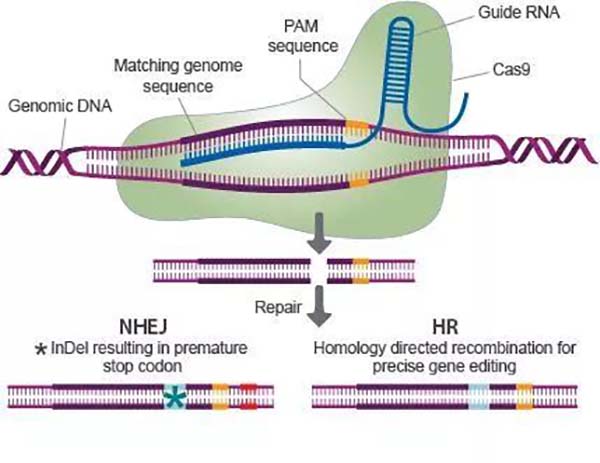- In-Stock Tumor Cell Lines
- Human Orbital Fibroblasts
- Human Microglia
- Human Pulmonary Alveolar Epithelial Cells
- Human Colonic Fibroblasts
- Human Type II Alveolar Epithelial Cells
- Human Valvular Interstitial Cells
- Human Thyroid Epithelial Cells
- C57BL/6 Mouse Dermal Fibroblasts
- Human Alveolar Macrophages
- Human Dermal Fibroblasts, Adult
- Human Lung Fibroblasts, Adult
- Human Retinal Muller Cells
- Human Articular Chondrocytes
- Human Retinal Pigment Epithelial Cells
- Human Pancreatic Islets of Langerhans Cells
- Human Kidney Podocyte Cells
- Human Renal Proximal Tubule Cells
What is CRISPR?
CRISPR-Cas9 is short for clustered regularly interspaced short palindromic repeats and CRISPR-associated protein 9.
CRISPR-Cas9 was adapted from a naturally occurring genome editing system in bacteria. The bacteria capture snippets of DNA from invading viruses and use them to create DNA segments known as CRISPR arrays. The CRISPR arrays allow the bacteria to “remember” the viruses (or closely related ones). If the viruses attack again, the bacteria produce RNA segments from the CRISPR arrays to target the viruses’ DNA. The bacteria then use Cas9 or a similar enzyme to cut the DNA apart, which disables the virus (Fig.1).


Fig1. CRISPR-Cas9 System in Bacteria
CRISPR Applications
Now, the CRISPR-Cas9 system has generated a lot of excitement in the scientific community because it is faster, cheaper, more accurate, and more efficient than other existing genome editing methods. CRISPR technology is a simple yet powerful tool for editing genomes. It allows researchers to efficiently alter DNA sequences, modify gene function, and make some stable cell lines (knockout stable cell line, knockin stable cell line and knockdown stable cell line).
The CRISPR-Cas9 system works similarly in the lab. Researchers create a small piece of RNA with a sgRNA sequence that binds to a specific target sequence of DNA in a genome to a creative ko or knockin stable cell line. And the RNA also binds to the Cas9. The sgRNA is used to recognize the DNA sequence, and the Cas9 enzyme cuts the DNA at the targeted location. Once the DNA is cut, we can use the cell’s DNA repair machinery to add or delete pieces of genetic material, or to make changes to the DNA by replacing an existing segment with a customized DNA sequence.
- So the CRISPR technology can be applied to the following aspects:
- ◆ CRISPR technology corrects genetic errors that cause disease;
- ◆ CRISPR technology resurrects certain species;
- ◆ CRISPR technology eliminates microbes that generate illness;
- ◆ CRISPR technology helps foster healthier new foods;
- ◆ CRISPR technology will eradicate the most dangerous pests on the planet.
CRISPR-Cas9 Gene Editing
CRISPR-Cas9 genome editing is achieved by transfecting a cell with the Cas9 protein along with a specially designed guide RNA (gRNA) that directs the cut through hybridization with its matching genomic sequence in the lab. Errors can occur to generate a gene knockout or additional genetic modifications can be introduced when the cell repairs break.
Cas9 unwinds the double-stranded DNA allowing the sgRNA to basepair with one strand and subsequently cleave both strands (fig.2).

Fig2. CRISPR-Cas9 Gene Editing
AcceGen’s CRISPR-Cas9
AcceGen provides you with a wealth of tools to help you with every step of the way in your genome editing workflow.
AcceGen’s CRISPR-CAS9 Advantages:
- ♢ Fast turnaround time and end-to-end services;
- ♢ High quality and proprietary technologies;
- ♢ Professional technical support;
- ♢ Cost-effective;
- ♢ One-stop-solution;
- ♢ Maximize your chances of success with our CRISPR-Cas9 editing guide.
For Custom Stable Cell line: Custom Stable Cell Lines Service
For Stable Cell Lines being Used: Knockout stable cell line Knockin stable cell line Stable cell line expressing Cas9

Copyright - Unless otherwise stated all contents of this website are AcceGen™ All Rights Reserved – Full details of the use of materials on this site please refer to AcceGen Editorial Policy – Guest Posts are welcome, by submitting a guest post to AcceGen you are agree to the AcceGen Guest Post Agreement – Any concerns please contact [email protected]








